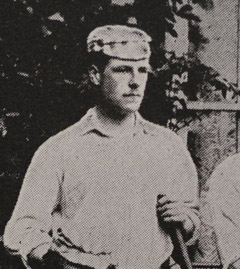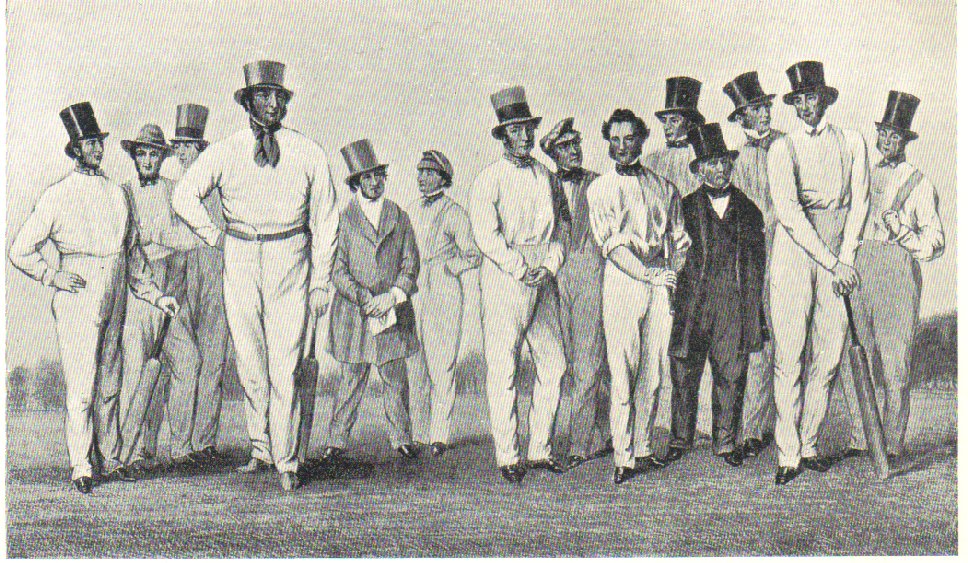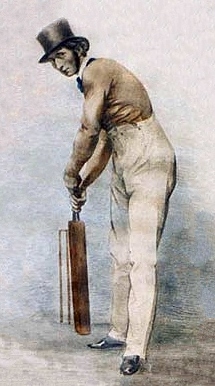|
Robert Copland-Crawford
Robert Erskine Wade Copland-Crawford (5 September 1852 – 23 May 1894) was a Scottish soldier and amateur sportsman. He played football four times for Scotland in the representative matches played between 1870 and 1872, scoring the opening goal in the first match. Crawford also played first class cricket for Marylebone Cricket Club (MCC) in 1872 and 1873. He served in the Afghan War from 1878 to 1880, and was mentioned in dispatches. He was later a police-officer in Sierra Leone, but ended his career in disgrace when he was imprisoned for causing the death of a native by flogging. Family and education Crawford was born in Elizabeth Castle, Jersey where his father, Captain Robert Fitzgerald Crawford was serving with the Royal Regiment of Artillery. He was raised in Edinburgh, before attending Harrow School between 1866 and 1871. At Harrow, he was a member of the school football XI between 1869 and 1871 and represented the school at cricket between 1868 and 1871. The family ... [...More Info...] [...Related Items...] OR: [Wikipedia] [Google] [Baidu] |
Fitzgerald Hamilton Crawford
Fitzgerald Hamilton Paul Copland-Crawford (5 May 1854 – 7 October 1894) was a Scottish amateur footballer who made two appearances in the representative matches in 1871 and 1872. Family Crawford was born in Edinburgh, the son of Lieutenant-Colonel Robert Fitzgerald Crawford of the Royal Regiment of Artillery, and his wife, Jane Dalrymple Anderson. The family name was changed to "Copland-Crawford" in September 1872. Football career Crawford was a member of the Harrow Chequers club, where he played alongside his elder brother Robert against the Wanderers in the opening match of the 1871–72 season, which ended scoreless. In the match report in the ''Morning Post'' on Monday, 16 October 1871, the Crawford brothers were commended for being "conspicuous for excellent play". Both brothers were later to become members of the Wanderers club. Crawford also played alongside his brother in the matches between England and Scotland played on 18 November 1871 and 24 February 1872, ... [...More Info...] [...Related Items...] OR: [Wikipedia] [Google] [Baidu] |
Battle Of Ahmed Khel
The Battle of Ahmed Khel took place during the Second Anglo-Afghan War. It was fought on 19 April 1880, on the road between Kandahar and Kabul in central Afghanistan between Afghan tribesmen and soldiers of the British Empire, including forces from both British and Indian armies. On 27 March 1880, Lieutenant General Donald Stewart, with a force of 7,200, left Kandahar in south Afghanistan to march to Kabul, in order to reinforce General Roberts, the British commander in the Afghan capital. During the journey, the country was largely deserted, creating difficulties in supplying the troops, while the column was shadowed by a large force of Afghan tribesmen. On 19 April 1880, the column was near the village of Ahmed Khel, about 23 miles from Ghazni. Here, at a point where the road narrowed, a force of about 12–15,000 Afghan tribesmen was in place along the hills, threatening the column's flank. As Stewart began to reposition his men to respond, the mass of Afghan tribesmen rush ... [...More Info...] [...Related Items...] OR: [Wikipedia] [Google] [Baidu] |
60th Rifles
The King's Royal Rifle Corps was an infantry rifle regiment of the British Army that was originally raised in British North America as the Royal American Regiment during the phase of the Seven Years' War in North America known in the United States as 'The French and Indian War.' Subsequently numbered the 60th Regiment of Foot, the regiment served for more than 200 years throughout the British Empire. In 1958, the regiment joined the Oxfordshire and Buckinghamshire Light Infantry and the Rifle Brigade in the Green Jackets Brigade and in 1966 the three regiments were formally amalgamated to become the Royal Green Jackets. The KRRC became the 2nd Battalion, Royal Green Jackets. On the disbandment of the 1st Battalion, Royal Green Jackets in 1992, the RGJ's KRRC battalion was redesignated as the 1st Battalion, Royal Green Jackets, eventually becoming 2nd Battalion, The Rifles in 2007. History French and Indian War The King's Royal Rifle Corps was raised in the American colonies i ... [...More Info...] [...Related Items...] OR: [Wikipedia] [Google] [Baidu] |
Sub-lieutenant
Sub-lieutenant is usually a junior officer rank, used in armies, navies and air forces. In most armies, sub-lieutenant is the lowest officer rank. However, in Brazil, it is the highest non-commissioned rank, and in Spain, it is the second highest non-commissioned rank. As a naval rank, a sub-lieutenant usually ranks below a lieutenant. Armies and air force rank In France, a sub-lieutenant () is the junior commissioned officer in the army or the air force. He wears a band in the colour of his corps (e.g. gold for infantry, silver for armoured cavalry, etc.). During the 18th century a rank of existed in the French Navy. It was the equivalent of the master's mate rank of the Royal Navy. It is now replaced by the rank of "first ensign" (). An Argentinian sub-lieutenant wears a single silver sun on each shoulder, Brazilian sub-lieutenants are the most senior non-commissioned rank (called Sub-Officer in the Navy and Air force), wearing a golden lozenge. In Mexico, the sub-lieute ... [...More Info...] [...Related Items...] OR: [Wikipedia] [Google] [Baidu] |
Militia (United Kingdom)
The Militia of the United Kingdom were the military reserve forces of the United Kingdom of Great Britain and Ireland after the Union in 1801 of the former Kingdom of Great Britain and Kingdom of Ireland. The militia was transformed into the Special Reserve by the Territorial and Reserve Forces Act 1907. For the period before the creation of the United Kingdom, in the home nations and their colonies, see Militia (Great Britain). Nineteenth century A separate voluntary Local Militia was created in 1808 before being disbanded in 1816. By 1813 the British Army was experiencing a shortage of manpower to maintain their battalions at full strength. Some consideration was given to recruiting foreign nationals; however on 4 November 1813 a bill was introduced to Parliament to allow Militia volunteers to serve in Europe. In the event only three battalions were raised, and these were sent to serve under Henry Bayly. On 12 April 1814 they arrived in Bordeaux, where they were attached to the ... [...More Info...] [...Related Items...] OR: [Wikipedia] [Google] [Baidu] |
England Cricket Team
The England cricket team represents England and Wales in international cricket. Since 1997, it has been governed by the England and Wales Cricket Board (ECB), having been previously governed by Marylebone Cricket Club (the MCC) since 1903. England, as a founding nation, is a Full Member of the International Cricket Council (ICC) with Test, One Day International (ODI) and Twenty20 International (T20I) status. Until the 1990s, Scottish and Irish players also played for England as those countries were not yet ICC members in their own right. England and Australia were the first teams to play a Test match (15–19 March 1877), and along with South Africa, these nations formed the Imperial Cricket Conference (the predecessor to today's International Cricket Council) on 15 June 1909. England and Australia also played the first ODI on 5 January 1971. England's first T20I was played on 13 June 2005, once more against Australia. , England have played 1,058 Test matches, winning 387 and lo ... [...More Info...] [...Related Items...] OR: [Wikipedia] [Google] [Baidu] |
Kent County Cricket Club
Kent County Cricket Club is one of the eighteen first-class county clubs within the domestic cricket structure of England and Wales. It represents the historic county of Kent. A club representing the county was first founded in 1842 but Kent teams have played top-class cricket since the early 18th century, and the club has always held first-class status. The current Kent County Cricket Club was formed on 6 December 1870 following the merger of two representative teams. Kent have competed in the County Championship since the official start of the competition in 1890 and have played in every top-level domestic cricket competition in England. The club's limited overs team is called the Kent Spitfires after the Supermarine Spitfire. The county has won the County Championship seven times, including one shared victory. Four wins came in the period between 1906 and 1913 with the other three coming during the 1970s when Kent also dominated one-day cricket cup competitions. A total ... [...More Info...] [...Related Items...] OR: [Wikipedia] [Google] [Baidu] |
George Harris, 4th Baron Harris
Colonel George Robert Canning Harris, 4th Baron Harris, (3 February 1851 – 24 March 1932), generally known as Lord Harris, was a British colonial administrator and Governor of Bombay. He was also an English amateur cricketer, mainly active from 1870 to 1889, who played for Kent and England as captain of both teams. He had a political career from 1885 to 1900 and was for much of his life a highly influential figure in cricket administration through the offices he held with Marylebone Cricket Club (MCC). He was President of the Kent County Football Association between 1881 and 1908. Early life The Honourable George Harris was born in St Ann's, Trinidad on 3 February 1851 when his father, George Harris, 3rd Baron Harris, was serving as Governor of Trinidad (1846–1854)Carlaw D (2020) ''Kent County Cricketers A to Z. Part One: 1806–1914'' (revised edition), p.216.Available onlineat the Association of Cricket Statisticians and Historians. Retrieved 11 March 2021.) and Sarah ( ... [...More Info...] [...Related Items...] OR: [Wikipedia] [Google] [Baidu] |
Century (cricket)
In cricket, a century is a score of 100 or more runs in a single innings by a batsman. The term is also included in "century partnership" which occurs when two batsmen add 100 runs to the team total when they are batting together. A century is regarded as a landmark score for batsmen and a player's number of centuries is generally recorded in their career statistics. Scoring a century is loosely equivalent in merit to a bowler taking a five-wicket haul, and is commonly referred to as a ton or hundred. Scores of more than 200 runs are still statistically counted as a century, although these scores are referred to as double (200–299 runs), triple (300–399 runs), and quadruple centuries (400–499 runs), and so on. Accordingly, reaching 50 runs in an innings is known as a half-century; if the batsman then goes on to score a century, the half-century is succeeded in statistics by the century. Scoring a century at Lord's earns the batsman a place on the Lord's honours boar ... [...More Info...] [...Related Items...] OR: [Wikipedia] [Google] [Baidu] |
I Zingari
I Zingari (from dialectalized Italian , meaning "the Gypsies"; corresponding to standard Italian ') are English and Australian amateur cricket clubs, founded in 1845 and 1888 respectively. It is the oldest and perhaps the most famous of the 'wandering' cricket clubs (without a home ground), and is well known for its historically aristocratic membership and its colours of black, red and gold, symbolising the motto "Out of darkness, through fire, into light". History The English club was formed on 4 July 1845 by a group of Old Harrovians at a dinner party and thus is one of the oldest cricket clubs still in existence. The English team still plays around 20 matches each year. Also known as IZ, I Zingari is a wandering (or nomadic) club, having no home ground. Uniquely for an amateur club, ''Wisden'' reported all of its matches since 1867, but ceased to do so in 2005. I Zingari was founded by John Loraine Baldwin, the Hon. Frederick Ponsonby (later 6th Earl of Bessborough), t ... [...More Info...] [...Related Items...] OR: [Wikipedia] [Google] [Baidu] |
Underarm Bowling
Underarm bowling is a style of bowling in cricket. The style is as old as the sport itself. Until the introduction of the roundarm style in the first half of the 19th century, bowling was performed in the same way as in the sport of bowls, with the ball being delivered with the hand below the waist. Bowls may well be an older game than cricket and it is possible that it provided a template for delivering a ball with a degree of accuracy. History For centuries, bowling in cricket was performed exactly as in the sport of bowls because the ball was rolled or skimmed along the ground. The bowlers may have used variations in pace but the basic action was essentially the same. There are surviving illustrations from the first half of the eighteenth century which depict the bowler with one knee bent forward and his bowling hand close to the ground, while the ball trundles (if slow) or skims (if quick) towards a batsman armed with a bat shaped something like a large hockey stick and g ... [...More Info...] [...Related Items...] OR: [Wikipedia] [Google] [Baidu] |








